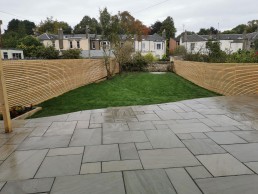Three fence types for your Highland garden
If your garden fence has seen better days, you might be thinking about an upgrade – but what type should you replace it with?
Ranch, picket fencing, featherboard, panel….the list goes on. There are lots of different fence styles to choose from, each with its own pros and cons.
It’s not all about style preferences though, there are practical factors to consider too. For instance, many gardens in Inverness and Ross-shire sit on high ground, or are built on hills – so when I’m advising customers, I always look at the lay of the land and how exposed the property is to wind.
That way, we can ensure that the fence type chosen will hold up on windy days and won’t draw attention to uneven ground.
The location and size of plants too, is also worth considering, and if you’re looking for a similar look indoors and out, you may want to match the modern or traditional quality of your house with a similar style in fencing.
It’s definitely not a one-size-fits-all decision, but if you’re thinking about upgrading, here are three popular types to consider:
Ranch-style fence

This is an alternative to more traditional vertical fencing, so it’s a popular choice with customers looking to create a modern finish or to stand out from their neighbours.
As with anything involving horizontal stripes, ranch fencing can make a space look bigger than it is.
The width of the boards can vary – if you have a large garden, six-inch boards work well, whereas smaller spaces benefit from narrower ones.
Ranch fencing is a good option for exposed homes – the spaces between the wood allows the wind to flow through.
It’s also better suited to gardens that are level; the horizontal boards can draw attention to any uneven ground otherwise.
Panel fence

Panel fences often come with a trellis added to the top. These are usually delivered pre-built and slot into place between posts.
The obvious benefit with this look is it offers total privacy and is a secure option for homeowners who prefer to keep the inside of their property hidden from potential intruders.
It’s also a good option if you and your neighbour are going 50/50 on a fence and want to have the exact same on both sides.
The potential downside is there are less gaps to let sunlight through – not so much a problem for large gardens, but more likely to be an issue for smaller spaces.
Panel fences are best suited to even or flat ground – but should be avoided if you live in a particularly windy area; they’re less likely to withstand strong gusts than styles with slats.
Slatted fence - a.k.a 'hit and miss' fence

Slatted fencing can be double-sided for full privacy, or single-sided if you prefer to have some visibility beyond your boundary.
If you’re going 50/50 with your neighbour, double-sided is best – otherwise you’ll have to draw straws to decide who ends up with exposed posts on their side of the fence.
Like ranch fencing, the spaces between posts allow the wind to pass through, making it a suitable fence option for windy areas.
The horizontal rails installed at half height make this an easier type of fencing to climb – useful for reaching a football that’s landed in a neighbour’s garden, but less appealing from a security point of view.
It is a good option though if your garden is uneven or on a hill – the fencing can be staggered to suit.
What's next?
Decided which style best suits your garden? If you’re looking at replacing or upgrading your fence in Inverness or Ross-shire, get in touch to arrange a consultation.

